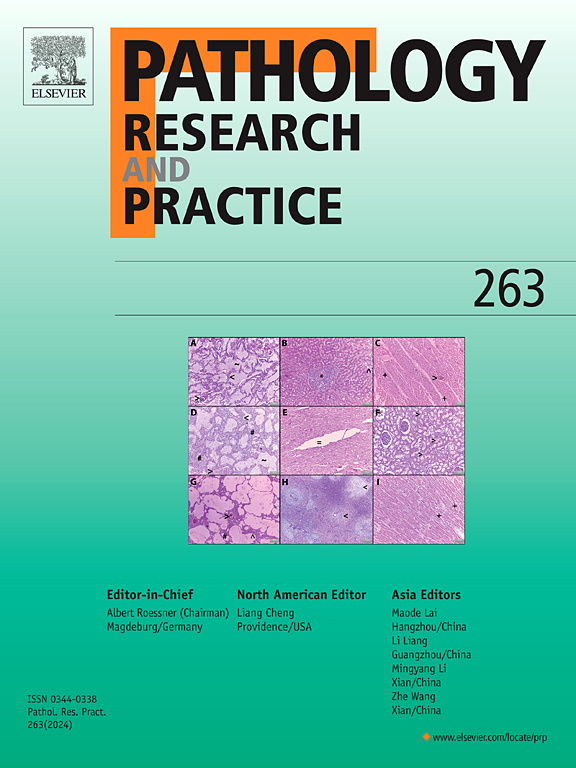多丹素通过降低PTGS2水平减轻慢性咳嗽中肺泡巨噬细胞的氧化应激和促炎激活
IF 3.2
4区 医学
Q2 PATHOLOGY
引用次数: 0
摘要
白藜芦醇是一种主要从虎杖中分离得到的白藜芦醇衍生物。调查。具有多种药理作用。本研究探讨多柚素(PD)治疗慢性咳嗽的疗效,并探讨其作用机制。方法对慢性咳嗽患者进行氨和辣椒素暴露后的PD治疗。采用组织学染色法测定小鼠肺组织的病理改变。在小鼠血清或肺组织样本中检测到炎症和氧化应激标志物。将小鼠肺泡巨噬细胞(MH-S)暴露于脂多糖(LPS)中产生炎症细胞模型。分析PD对炎症细胞因子产生和细胞氧化应激的治疗作用。利用生物信息学工具预测PD的下游靶点。在动物和细胞模型中诱导前列腺素内过氧化物合成酶2 (PTGS2)过表达,分析其在PD中的作用。结果spd治疗增加了模型小鼠的咳嗽潜伏期,降低了咳嗽频率,改善了小鼠肺组织中炎症细胞的浸润、胶原沉积和粘液的产生。此外,PD治疗降低了小鼠和lps挑战的MH-S细胞的炎症细胞因子产生和氧化应激标志物。PD降低小鼠肺组织和MH-S细胞中PTGS2蛋白水平。通过慢病毒载体导入PTGS2过表达,在体内和体外均显著抵消PD的治疗效果。结论PD治疗可通过降低PTGS2蛋白水平,降低肺泡巨噬细胞的氧化应激和促炎激活,从而改善小鼠慢性咳嗽。本文章由计算机程序翻译,如有差异,请以英文原文为准。
Polydatin alleviates oxidative stress and pro-inflammatory activation of alveolar macrophages in chronic cough by reducing PTGS2 levels
Background
Polydatin (PD) is a resveratrol derivative primarily isolated from Polygonum cuspidatum Sieb. et Zucc. with multiple pharmacological effects. This research investigates the treatment effect of polydatin (PD) on chronic cough and delves into its functional mechanism.
Methods
Mice with chronic cough were generated through ammonia and capsaicin exposure, followed by PD treatment. Pathological alterations in the mouse lung tissues were determined using histological staining. Inflammation and oxidative stress markers were detected in the mouse serum or lung tissue samples. Mouse alveolar macrophages, MH-S, were exposed to lipopolysaccharide (LPS) to generate inflammatory cell models. The treatment effect of PD on inflammatory cytokine production and oxidative stress in cells was analyzed. Downstream targets of PD were predicted using bioinformatics tools. Prostaglandin-endoperoxide synthase 2 (PTGS2) overexpression was induced in animal and cell models to analyze its involvement in PD's effects.
Results
PD treatment increased latency to cough and reduced cough frequencies of modeled mice, and it ameliorated inflammatory cell infiltration, collagen deposition, and mucus production in mouse lung tissues. Additionally, PD treatment reduced inflammatory cytokine production and oxidative stress markers both in mice and in LPS-challenged MH-S cells. PD reduced PTGS2 protein levels in mouse lung tissues and MH-S cells. Overexpression of PTGS2, introduced via lentiviral vectors, significantly counteracted the treatment effects of PD both in vivo and in vitro.
Conclusion
This research demonstrates that PD treatment reduces oxidative stress and pro-inflammatory activation of alveolar macrophages to ameliorate chronic cough in mice by reducing PTGS2 protein levels.
求助全文
通过发布文献求助,成功后即可免费获取论文全文。
去求助
来源期刊
CiteScore
5.00
自引率
3.60%
发文量
405
审稿时长
24 days
期刊介绍:
Pathology, Research and Practice provides accessible coverage of the most recent developments across the entire field of pathology: Reviews focus on recent progress in pathology, while Comments look at interesting current problems and at hypotheses for future developments in pathology. Original Papers present novel findings on all aspects of general, anatomic and molecular pathology. Rapid Communications inform readers on preliminary findings that may be relevant for further studies and need to be communicated quickly. Teaching Cases look at new aspects or special diagnostic problems of diseases and at case reports relevant for the pathologist''s practice.

 求助内容:
求助内容: 应助结果提醒方式:
应助结果提醒方式:


